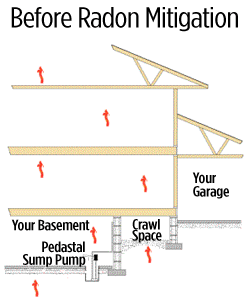Since you cannot see or smell radon, special equipment is needed to detect it.
These testing devices should be placed in the lowest level of the home that is suitable for occupancy. This means testing in the lowest level currently lived in OR a lower level not currently used, such as a basement, which could be used in the course of daily living. The test should be in a room to be used regularly but NOT a kitchen, bathroom or laundry room.
You can buy radon devices in retail stores, send away for radon devices from laboratories that offer mail order services, or you can hire an EPA or State Certified Radon tester who will test using radon devices that are appropriate for the situation.
Types of Testing Devices
Radon testing equipment is divided into two categories: Passive Devices and Active Devices.
Passive Devices – Passive radon testing devices do not need power to function. They include radon detectors such as charcoal canisters, alpha-track detectors, charcoal liquid scintillation devices, and electret ion chamber detectors. These devices are exposed to the air in the home for a specified period of time and then sent to a laboratory for analysis.
Active Devices – Active testing devices require power to function. Active radon detectors such as continuous radon monitors and continuous working level monitors require operation by trained, state-certified testers. They work by continuously measuring and recording the amount of radon or its decay products in the air of the home. Many of these devices provide a report of this information which can reveal any unusual or abnormal swings in the radon level during the test period. A professional, state-certified tester can explain this report to you.
Make sure the radon device is listed by EPA’s testing program or is state-certified. The device may display the phrase “Meets EPA Requirements” or “EPA listed.” Also, there are important procedures that must be followed while a radon test is in process. A state-certified radon tester can tell you more about radon testing devices and procedures that are necessary in order to get accurate test results.
Short-Term and Long-Term Testing
The quickest way to test is with short-term tests. Short-term tests remain in your home from two days to 90 days. depending on the device. Because radon levels tend to vary from day to day and season to season, a short-term test is less likely than a long-term test to tell you your year-round average radon level. However, if you need results quickly, short-term testing may be used to decide whether to fix the home.
Long-term tests remain in your home for more than 90 days. Alpha track and electret ion chamber detectors are commonly used for this type of testing. A long-term test will give you a reading that is more likely to tell you you home’s year-round average radon level than a short-term test.
Testing in a Real Estate Transaction
The EPA’s Home Buyer’s and Seller’s Guide to Radon says:
If you are testing in a real estate transaction and you need results quickly, any of the following three ways to conduct Short-Term Tests are acceptable for determining whether the home should be fixed.
Passive:
Take an initial short-term test for at least 48 hours. After the first test has been completed, take a follow-up short term test for at least 48 hours.
Or
Take two short-term tests at the same time in the same location for at least 48 hours.
EPA Recommends: Fix the home if the average of two tests is 4pCi/l or more.
Active:
Test the home with a continuous monitor for at least 48 hours.
EPA Recommends: Fix the home if the average radon level is 4 picocuries per liter (pCi/l) or higher.
Once I’ve tested and I get the results, What should I do next?




